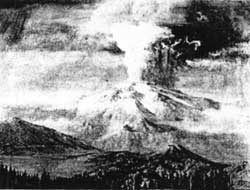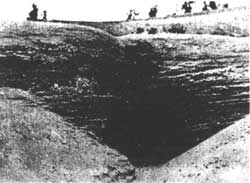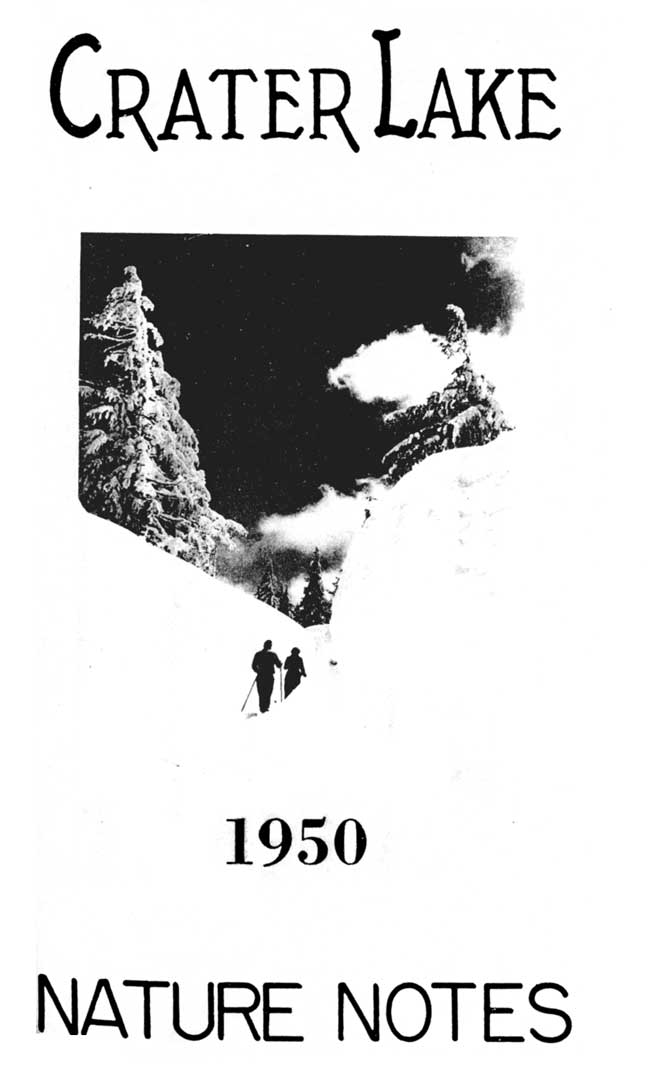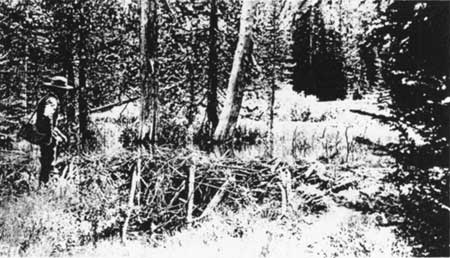Volume 16, 1950
All material courtesy of the National Park Service. These publications can also be found at http://npshistory.com/
Nature Notes is produced by the National Park Service. © 1950
A Return of the Ice Ages
 Mt. Mazama and Its Glaciers from a Painting by Paul Rockwood |
In the flatlands of eastern North America continental glaciation occurred on a large scale in recent geological times. Snow fell in such quantities that summer melting failed to keep pace with winter accumulation and eventually glaciers resulted. Moving in all directions from their source in central Canada, they invaded the area of what is now the United States as far southward as the present location of the Ohio and Missouri Rivers. A time of lighter snowfall or increased temperatures resulted in a wasting away of the glaciers until they had entirely disappeared. This cycle was repeated a number of times; the last of the four continental glaciers – the Wisconsin – wasted away some 22,000 years ago.
In the higher mountains such as the Cascades local valley glaciers existed rather than the ice sheets which completely mantled the lower lands to the eastward. The evidence of glacial drift separated by layers of volcanic rock indicate, however, the same response to climatic variation. In the mountain areas where valley glaciers still exist the present trend of the glaciers is toward smaller size. Annual measurements in Glacier and Mount Rainier National Parks demonstrate that summer wastage exceeds winter accumulation so that year by year the glaciers decrease in size.
Supporting data of decreased precipitation or increased evaporation is contributed by numerous lakes in the western areas of the United States. During recent geological times a larger Great Salt Lake covered much more area than its shrunken remnant. At its maximum size, its predecessor, “Lake Bonneville,” was 1000 feet deeper and overflowed its basin on the north into the Snake River: it was undoubtedly a fresh water lake. At the same time Lake Lahontan in Nevada covered a large area; its existing remnants are Walker, Pyramid, and Humboldt Lakes. Death Valley also supported a lake in recent geological times.
Accurate weather records have been kept for such a short time that they can not reveal long time trends. Short cycles of temperature and precipitation, influenced no doubt by sun-spots, are known, but we must turn to the geological record for the longer trends. If the present trend continues, we should expect our valley glaciers to continue to decrease in size until most of them have disappeared. Likewise the semiarid end arid portions of the western United States would increase in size and aridity. How far this cycle will continue is, of course, problematical. Higher areas such as the Cascades should continue to receive more precipitation than the lowlands even though there might be some decrease of winter snowfall. At least a few of the mountain glaciers should persist. The prediction of the future is further complicated by the fact that transition from the culmination of one age to the next is not constant but has many irregular variations.
Although 22,000 years seems a long time, in the geological story it is but a moment. The climate seems to be becoming warmer and drier, but may not there be a reversal toward colder and wetter conditions again sometime in the future? Each of the intervals between the ice sheets of the Ice Age was greatly longer than the 22,000 years that have elapsed since the Wisconsin sheet withdrew. From interglacial deposits in the Don River valley near Toronto fossils of both plants and animals that now are found no farther north than Missouri and Kentucky have been found. The climate of the northern United States and southern Canada may well continue to ameliorate for thousands of years to come.
Before we postulate a possible continuance of the Ice Age with the formation of another continental glacier in the East and numerous valley glaciers in the mountains, it is well to inquire into the causes of Ice Ages. Each of the times of extensive glaciation in the geological past has coincided with a time of great mountain building although the exact mechanics and the explanation of the four separate ice advances of the Pleistocene Ice Age are unknown.
One of the great mountain-making epochs of the earth is the present. Perhaps the lands of the earth still are high enough for another reoccurrence of glaciation on a large scale. If so, however, our climate undoubtedly will continue to get warmer, and in some areas drier, for some tens of thousands of years before a reversal of conditions occurs. And even if a fifth stage does occur, the Crater Lake National Park area and Mount Mazama will not be affected as much as they were in the past. Mount Mazama was high enough to support glaciers comparable to those of Mount Rainier of today. But now Mount Mazama has lost its higher elevations and the return of glacial conditions could produce no more than a few small glaciers. Mount Scott supported a large enough glacier to excavate the northern segment of the mountain and with a return of extensive glaciation it undoubted!, would support another. The only other possibilities seem to be for small, isolated glaciers that would occupy very limited areas since most regions in the Cascades with elevations no higher than those in the park did not support glaciers in the past and there is no reason to suppose that they would in the future.
Additions to the Flora of Crater Lake National Park
During the seasons of 1949 and 1950, while doing extensive work or the plants of Crater Lake National Park, Klamath County, Oregon, a considerable number were collected which proved to be new records Other collections were made which helped to substantiate reports of plants previously listed as growing here but for which no study material was available. Several species appeared to be adventive since the last publication on the flora.
The plants discussed in this report are either not mentioned in “Plants of Crater Lake National Park” by E. I. Applegate (1939) or have proved to be of sufficient interest to warrant additional discussion. All were the writer’s own collections except as indicated in the text. Specimens are deposited in the Herbarium at Headquarters, Crater Lake National Park.
Bromus tectorum L. Downy Brome – Grass.
Dry ground, near the south entrance. No. 6896. Very abundant throughout eastern Oregon. Introduced from Europe.
Glyceria pauciflora Presl. Few-Flowered Manna-Grass.
Along Red Blanket Creek in the southwest section of the park, at the boundary marker below Red Blanket Creek Spring. No. 6422. This plant is widely distributed in swampy ground from California to Alaska, and eastward to the Rocky Mountains.
Deschampsia danthonioides (Trin.) Munro.
Annual Hair-Grass. Moist ground, lower Annie Creek Canyon near the south entrance to the park. No. 6914. Grows throughout western region, at lower elevations, from Alaska to Mexico.
Carex campylocarpa Holm. Crater Lake Sedge.
Munson Meadow just below the park headquarters. No. 6441. Crater Lake is the type locality for this interesting species. Some authors include it with C. gymnoclada Holm, the Sierra Alpine Sedge. It appears to be sufficiently different, however, to maintain it as a separate entity. The species is commonly found on alpine stream banks in the Cascade and Wallowa Mountains of Oregon and in the mountains of Washington.
Carex epapillosa Mack. Smooth-fruited Sedge.
Along a small stream on the east slope below the crater rim, south of Kerr Notch. No. 6270. This plant is recorded from mountain meadows in the high Cascades of Oregon and Washington, the Rocky Mountains, and the Sierra Nevada.
Eriogonum compositum Dougl. Heart-Leaved Eriogonum.
Collected by Elmer I. Applegate on Crescent Ridge just north of National Creek. No. 11338. A common species of the arid regions of eastern Oregon. It has been found in the Calapooya Mountains a little farther to the northwest by the writer. The Crescent Ridge collection represents an interesting occurrence of the plant on the west slope of the Cascades. In the park it has been confused with E. elatum Dougl., Tall Eriogonum, which is found around Klamath Falls in the park region.
Polygonum cascadense W. H. Baker. Cascade Knotweed.
North wall of Red Blanket Canyon, southwest corner of the park. No. 6995. The type was collected on the south slope of Fairview Mountain in the Calapooya Range, Oregon. The known range is from the McKenzie Pass to Crater Lake National Park in the Cascades and in the Calapooya Mountains. Previous collections of this plant in the park have been confused with other species of Polygonum.
Trifolium hybridum L. Alsike Clover.
Along the highway at Polebridge Creek. No. 7185. Introduced; a common cultivated plant.
Lathyrus nuttalii S. Wats. Nuttall’s Pea.
Open woods at Copeland Creek Crossing. No. 7206. Occurs usually west of the Cascades in Oregon but it is recorded locally in Klamath County. Found from Vancouver Island and western Washington south to northern California. It differs from L. nevadensis Wats., Nevada Pea, in having thin leaves with inconspicuous veining and pubescent pods.
Lathyrus bijugatus White var. Sandbergii White. Pine-Woods Pea.
Open woods and hillsides in the vicinity of Copeland Creek Meadows. No. 7205. A plant of the open woods growing along the eastern base of the Cascades from Klamath County northward to Washington and Idaho. It is distinguished from other species ofLathyrus in the park by its very narrow linear or linear-lanceolate leaves.
Lomatium nudicaule (Pursh) C. & R. Naked Desert Parsley.
North wall of Red Blanket Canyon, southwest corner of the park. No. 7006. It is easily recognized by the naked stem and because the peduncles are strongly dilated at the summit. Recorded as growing in dry sterile ground from Oregon, Washington, and California, eastward to Idaho.
Phyllodoce empetriformis (Smith) G. Don. Red Mountain Heath.
Woods near the rim on the east slope just south of Kerr Notch. No. 6276. Along a stream below the crater rim south of Kerr Notch. No. 7146. Wooded ridge south of Kerr Notch. No. 7137. Applegate lists this in his publication but states that he did not collect it within the, park. It is recorded by Wynd, No. 2390, from Llao Rock. The plan appears to be fairly common on the east slope below the crater rim.
Collomia heterophylla Hook. Varied-leaved Collomia.
North wall of Red Blanket Canyon, southwest corner of the park. No. 6992. Widely distributed in open woods and thickets from Vancouver Island to California.
Rudbeckia occidentalis Nutt. Western Cone-Flower. Niggerhead.
Wet marshy ground at Copeland Creek Crossing. No. 6327. The ray flowers are absent in this species. It presents a rather unusual appearance and is sometimes known as niggerhead. The plant has been confused in the park with a related species, R. californica Gray, California Cone-Flower, which has rays present and grows commonly farther south. Abundant is the Siskiyou and Blue Mountains, but is present locally in the southern Cascades of Oregon as well.
Agoseris heterophylla (Nutt.) Greene. Annual Agoseris.
Lower Annie Creek Canyon near the south entrance to the park. No. 6915. It is widely distributed on dry open ground from British Columbia to California and east to Utah.
Eupatorium occidentale Hook. Western Boneset.
This plant is not recorded by Applegate, “Plants of Crater Lake National Park,” although he had apparently collected it in the park, No. 10044 from Wineglass and No. 9215 from the lava flow on the west side of Wizard Island. It was collected by the writer on Wizard Island among the lava rocks on the south shore near the boat landings: No. 6358. Wizard Island along the west shore at the base of large lava boulders on the west flow: No. 6364. It is also present on the Phantom Ship and on the Lake and Garfield Peak Trails.
Beaver and Their Works
Wild animal life is a feature in all our national parks that every visitor enjoys observing and wants to learn more about. Whether it be a little golden-mantled ground squirrel begging for peanuts, a mama bear and her cubs parading through the campground, or a deer gracefully hurdling an obstruction by the roadside, we are tremendously absorbed and interested. Some of our most common animals are usually active at night and not ordinarily seen by man, so that their habits can only be learned through long end patient observations at unconventional hours. These animals are the more interesting once they are understood. Among these is the beaver whose life history and accomplishments present a truly amazing story. He builds dams, lodges, and canals with a skill that sometimes resembles that of man, he can fell trees three feet in diameter, and can swim a half-mile under water and his pelt is closely woven into the fabric of the early history of our country.
The beaver belongs to the same order of gnawing mammals as the ground squirrels, marmots, and mice. It is, except for the capabara of Central America, the largest rodent in the world. An individual is three to four feet long and weighs forty pounds on an average, although the exceptional individual may weigh more than seventy-five pounds.
Protruding in front of the lips are long sharp chisel-like incisors which a beaver must have to build his home and secure his food. A single beaver can rend a four-inch sapling within a few minutes using his incisors to gouge and pry out long shavings. The incisors grow throughout the life time of the animal, but the functional ends are worn by use as rapidly as they grow from the gum. If by some accident a incisor should be knocked out of place so that if failed to balance the, opposite one, the latter can become so long that the animal is unable, to open his mouth wide enough to eat, and would die of starvation.
Beaver are adapted for a life spent largely in the water. The thick muscular tail is the most conspicuous organ, and the most distinguishing part about him. It occupies about a foot of his total length, is half that wide and shaped like a paddle. Actually, the tail is used as a rudder while swimming rather than as a propelling implement. When alarmed it is used as a signal by slapping the water during the process of diving. The tail is also used for balancing, when the animal stands on its hind legs to fell trees. The hind feet are well adapted for movement in the water. They are broad and webbed like those of a duck. The reference to old timers from Oregon, the beaver state, as “web-footed” has this fact as its origin.
Beaver usually select a wide slow-moving stream or pond in which to build their homes. If such a situation is not available they create it artificially by building a dam across a stream. Alternately layers of sticks, laid parallel to the stream current, and mud are gradually made water tight as silt is added by the stream. Long dams take several seasons to build.
The most nearly typical beaver home is a house in the middle of a pond backed up by a dam. An island of mud and rock is made in the pond and a roughly circular pile of branches and mud heaped on it. The beaver then burrows up from the bottom of the island. He starts the burrow far enough below the surface of the water to be beneath the ice in the winter. The single room is then excavated and fashioned by gnawing away the interior of the stick and mud pile until the cavity is of the desired size. The interior of a house is large enough to accommodate a household of six to eight beaver. John Colter, the first white man to see the area of Yellowstone National Park, is said to have escaped from Indians by diving into a beaver house. Beaver likewise are secure from enemies in their houses isolated by water. In Crater Lake National Park beaver solve their housing problem by making burrows in stream banks.
Beaver are located on Copeland and Bybee Creeks and the lower part of Annie Creek within the park. The most immediate indication of their presence is evidence of their workings. A tree may be left standing by only the smallest splinter, completely girdled by a V-shaped cut. When the trunk is completely severed the ends of the stump and tree are cone-shaped – a sure sign that beaver are at work. Also the bases of standing trees and the whole of dead prone trees are stripped of bark. The inner layer of bark, the cambium, is the mainstay of a beaver’s diet. Lodgepole pines and Douglas firs are common food in the park, although willows, alders, and aspens are taken when available.
A stand of trees close at hand and suitable for eating is as important as a pond for beaver. The supply of edible trees is the chief factor determining the length of time a home site will be occupied. Once downed, a tree is cut into lengths for transport to the pond. This may be done in canals built for the purpose, or if the distance is short the section is dragged to the water. The logs may be sunk in the mud bottom of the pond and stored for food, or used for building. Once the bark has been eaten the remainder of a log can conveniently be added to the house or dam.
The family life of beaver is a model one. They are monogamous and mate for life. A household usually consists of the two parents baby beaver born that year, and yearlings or kits. The young are born in April, and stay with the household until the second spring when they are forced by the parents to leave and start on their own. Occasionally the young will build a new house in the same pond and gradually a colony comes into being. Numbers offer protection against enemies. Thus, the river otter will attack a single beaver, but wisely refrains from molesting a whole colony. At the time the mother beaver is giving birth to her pups the father leaves the house for several weeks and leads a solitary life in a bank burrow until all the trouble is over.
The beaver has been of great value to man for his pelt and meat. Beaver pelts stimulated early exploration of North America, and were the basis for the founding of the Hudson’s Bay Co. In the early days beaver pelts were a medium of exchange or barter when money was scarce or lacking. Many towns and villages in various parts of the country have the word beaver in their names, reminiscent of the part beaver played in their history. Beaver, once abounding in the streams of the north and west of North America, were trapped so extensively that many states, including Oregon, made it unlawful to trap them at any season until they once again became more abundant.
In areas in which they build numerous dams, beaver are valuable in holding the water table at a higher level, in preventing excessive erosion, and retarding runoff. After a pond has been abandoned, it fills with fine stream silt and becomes a fertile meadow excellent for farming or grazing for many years.
All of our wild animals have a fascinating life story. Many of their habits and actions seem quite logical even to our practical, opinionated minds. All our forest creatures belong to a wildlife community in which each unconsciously contributes to its stability and maintenance.
Active Rock Slides
 Bedded Sands |
“Oh, look at the rocks tumbling down!” is a frequent comment of park visitors as they observe the rocks of the ancient Mazama rolling and bouncing down the caldera wall to a resting place in the waters of the lake.
There are many places along the inside wall of the volcanic caldera where active rocksliding constantly occurs. Near Chaski Bay and along the west section of the caldera by Wizard Island are some of the many places where large fan- shaped deposits consisting of various sized debris can be seen. The large gully-like depression immediately east of the Sinnott Memorial offers an excellent example of this process which is destroying the lake wall, making a very strong factor in its ultimate disappearance.
The walls of Mazama consist of volcanic fragmental and glacial debris, interbedded with well-fractured lava flows. The individual components, particularly of the first two members, are poorly held together and their unsupported ends incline at an angle of fifty or more degrees on the inside of the caldera.
Many factors contribute to the downward movement of the rock debris. Most important is melt-water derived from snow that accumulates to great thicknesses on the rock walls. This gives lubricating and hydraulic action for the removal of fine rock particles that support larger debris. Once a slide is started, more material of all sizes is dislodged along the paths. These tumble and bounce from one rock ledge to another, breaking off the edges, filling crevices crossed enroute, cutting their way through snow fields, and only slopping far below. Winds blowing against the walls also loosen fine particles which are supporting more massive material and help to start rock movement. Scurrying movements of small animals and tremblors caused by the rumbles of vehicles passing on the road, by thunder, or by distant slides are other contributing factors.
As rock slides and other forms of erosion transport material from the caldera wall to the bottom of the lake the caldera wall becomes lower and less steep; rock slides become increasingly less important. At the same time the accumulation of rock debris at the bottom of the caldera tends to fill the depression. Eventually, many thousand of years in the future, the lake will disappear by their combined action. Before the lake entirely disappears, the gradual reduction of the steepness of the caldera wall should result in the cessation of rock sliding as the more usual methods of erosion assume predominance.
Mammal Puzzles
Where did it come from?
 The mystery was deepened by the fact that the stranger appeared suddenly about the middle of August, and seemed to be quite tame. Visitors were happy over another animal which could be fed peanuts! On August 21, the little animal was brought to Park Headquarters for examination. In general appearance it was obviously a member of the ground-squirrel genus Citellus, but to what species did it belong? The body had no distinct pelage pattern; as had been described, the ears were very short, the feet quite large, and the tail short in relation to the body length. Not infrequently an animal is recorded from a locality where it has never before been known to occur. Such was reported by several members of the staff, Crater Lake Lodge employees, and some park visitors. Various descriptions were given of a strange creature living near the lakeside porch of the lodge. Descriptions were as varied as the number of reports, but all observers agreed that the new animal was squirrel-like in appearance, gray in color, very short-eared, and with a tail rather short for the body length. Some fantastic postulations were made, such as the possibility of a mutation of the golden-mantled ground squirrel, or of a hybrid between the ground-squirrel and the arboreal chickadee!
The mystery was deepened by the fact that the stranger appeared suddenly about the middle of August, and seemed to be quite tame. Visitors were happy over another animal which could be fed peanuts! On August 21, the little animal was brought to Park Headquarters for examination. In general appearance it was obviously a member of the ground-squirrel genus Citellus, but to what species did it belong? The body had no distinct pelage pattern; as had been described, the ears were very short, the feet quite large, and the tail short in relation to the body length. Not infrequently an animal is recorded from a locality where it has never before been known to occur. Such was reported by several members of the staff, Crater Lake Lodge employees, and some park visitors. Various descriptions were given of a strange creature living near the lakeside porch of the lodge. Descriptions were as varied as the number of reports, but all observers agreed that the new animal was squirrel-like in appearance, gray in color, very short-eared, and with a tail rather short for the body length. Some fantastic postulations were made, such as the possibility of a mutation of the golden-mantled ground squirrel, or of a hybrid between the ground-squirrel and the arboreal chickadee!
From a careful check on descriptions of Citellus in Anthony’s Field Book of North American Mammals (1928), and Bailey’s Mammals and Life Zones of Oregon (1936), this specimen can apparently be only C. oregonus (Merriam), the Oregon ground-squirrel. This knowledge, however, doesn’t explain how it came to occupy the vicinity of the lodge porch. This question of origin is particularly interesting in light of the fact that this is the first authentic record of this species in Crater Lake National Park.
Because the new visitor appeared suddenly, and was quite tame, it was probably brought in by a tourist. Whatever the cause of its arrival, it now is a permanent resident of the park zoological collection, available for reference and demonstration purposes.
Why did it die?
A Rocky Mountain mule deer fawn (Odocoileus hemionus hemionus) was found in a weakened condition in the northeastern part of the park on August 22. The trail crew came across the little buck when they stopped to eat lunch. It appeared to be hungry, perhaps even starving, so they offered it some of their lunch milk, which it gulped avidly.
The crew foreman put the fawn in his pick-up and brought it to headquarters, but it died on the way. Weighed and measured at the warehouse, it was very slight for the body dimensions. It weighed 28 pounds and was 42 inches in total length. It was at least three months old according to the degree of tooth eruption. A brief field autopsy showed no obvious parasitic condition to cause death, and no easily detectable disease symptoms. The ruminant stomach was about half full of vegetable food, but seemed to be deficient in moisture content.
The dental condition also did not indicate an inability to feed on browse, as the deciduous teeth were all functional, and the last molars had just penetrated the gum line. There was no mesenteric or subcutaneous fat on the fawn, and the general appearance of the animal was of gaunt hunger. Had his mother met an untimely end? Was he not yet weaned, and the food in his stomach only a desperation attempt to survive? Why did he die in infancy, and what factors brought on his death? Here are questions one asks of nature.
What is he doing here?
On the evening of August 19, while talking to some park guests on the lakeside porch of the lodge, a cony (Ochotona princeps) was seen several times hopping across the lighted area before the open lounge doors. Since lodge porches are definitely not the habitat favored by conies, and as they are not known to relish peanuts or other park visitor squirrel-bait, what was this rock-loving cousin of the rabbit doing here? Perhaps he was curious about the activity in the lounge, as he stopped and seemed to peer inside the open doors each time he traversed the lighted area.
Other pages in this section




